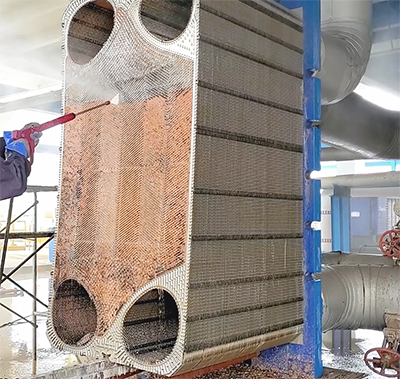Heat exchangers are key components of many industrial and residential heating systems. It is responsible for transferring heat from one fluid to another, allowing for efficient heating and cooling processes. However, one common problem that can occur with a heat exchanger is clogging, which can seriously affect its performance and efficiency. In this article, we will explore the causes of clogged heat exchangers and the potential consequences of this problem.
A clogged heat exchanger can be caused by a variety of factors, including a buildup of debris, scale, or corrosion within the exchanger. Over time, debris such as dirt, dust, and other particulate matter can accumulate and block the flow of fluid through the exchanger. Likewise, scale, formed by mineral deposits in the fluid, can accumulate on the surfaces of the exchanger, impeding heat transfer. Corrosion caused by the interaction between exchanger materials and fluids can also lead to clogging and reduced efficiency.
One of the main causes of clogged heat exchangers is insufficient maintenance. Without regular cleaning and inspection, debris and scale can accumulate uncontrollably, causing clogs and reducing heat transfer efficiency. Additionally, poor water quality in the system can lead to scaling and corrosion, further exacerbating clogging problems.
Another potential cause of a clogged heat exchanger is the use of inappropriate fluids or operating conditions. Incompatibility between fluid and exchanger materials can lead to corrosion and deposit formation, ultimately leading to clogging. Likewise, operating a heat exchanger at extreme temperatures or pressures can accelerate the accumulation of debris and scale, leading to clogs and reduced performance.

The consequences of a clogged heat exchanger can be serious. Reduced heat transfer efficiency results in increased energy consumption and higher operating costs. In addition, blockages can cause uneven heating or cooling within the system, causing temperature fluctuations and potential damage to sensitive components. Additionally, blockages increase the risk of equipment failure and downtime, impact productivity, and can lead to costly repairs or replacements.
To prevent and resolve heat exchanger blockages, regular maintenance and cleaning is essential. This includes regularly inspecting the exchanger for signs of blockage and cleaning internal surfaces to remove debris, scale and corrosion. Additionally, monitoring and maintaining water quality in your system can help prevent scale formation and reduce the risk of corrosion.
In some cases, chemical treatment or descaling procedures may be required to remove stubborn deposits and restore the efficiency of the heat exchanger. Always consult a qualified technician or engineer to determine the most appropriate measures to resolve a clogged heat exchanger problem.
In summary, a clogged heat exchanger can be caused by a variety of factors, including the accumulation of debris, scale, and corrosion. Insufficient maintenance, poor water quality, and improper operating conditions can all cause clogs. The consequences of a clogged heat exchanger can be severe, affecting energy efficiency, system performance and equipment reliability. By implementing regular maintenance and cleaning procedures and monitoring water quality and operating conditions, the risk of heat exchanger blockage can be minimized, ensuring optimal performance and longevity of the system.
Post time: Aug-01-2024

